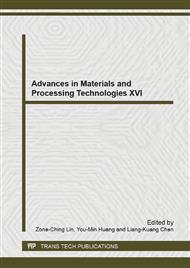p.322
p.328
p.336
p.342
p.349
p.355
p.361
p.367
p.373
Precision Glass Molding of High Filling Factor Micro Lens Arrays
Abstract:
Glass micro lens arrays (GMLAs) have several advantages such as a high transmission rate, anti-environment, and can be used for special wavelength applications. Precision glass molding (PGM) has been used to mass produce high-accuracy aspherical glass lenses. Ultra-precision diamond grinding (UPDG) is a fundamental part of the precision glass molding process. Using UPDG, grinding spherical and aspherical to sub-micrometer form and nanometer surface roughness is simple. However, asymmetrical surface MLAs are difficult to generate using the UPDG process. UPDG, together with the wheel-forming method and a strategy used to separate the entire surface generation process into several grinding loops, were studied and developed to generate high filling factor MLAs on the mold surface. The GMLA material used was K-CSK120, made by Sumita Inc., Japan. Finally, GMLAs with an approximately 100% filling factor were generated using PGM with form accuracy and surface roughness that were respectively less than 0.3 μm and 10 nm. The tolerance of each single micro lens figure was greater than 95%.
Info:
Periodical:
Pages:
349-354
Citation:
Online since:
May 2014
Authors:
Price:
Сopyright:
© 2014 Trans Tech Publications Ltd. All Rights Reserved
Share:
Citation:


